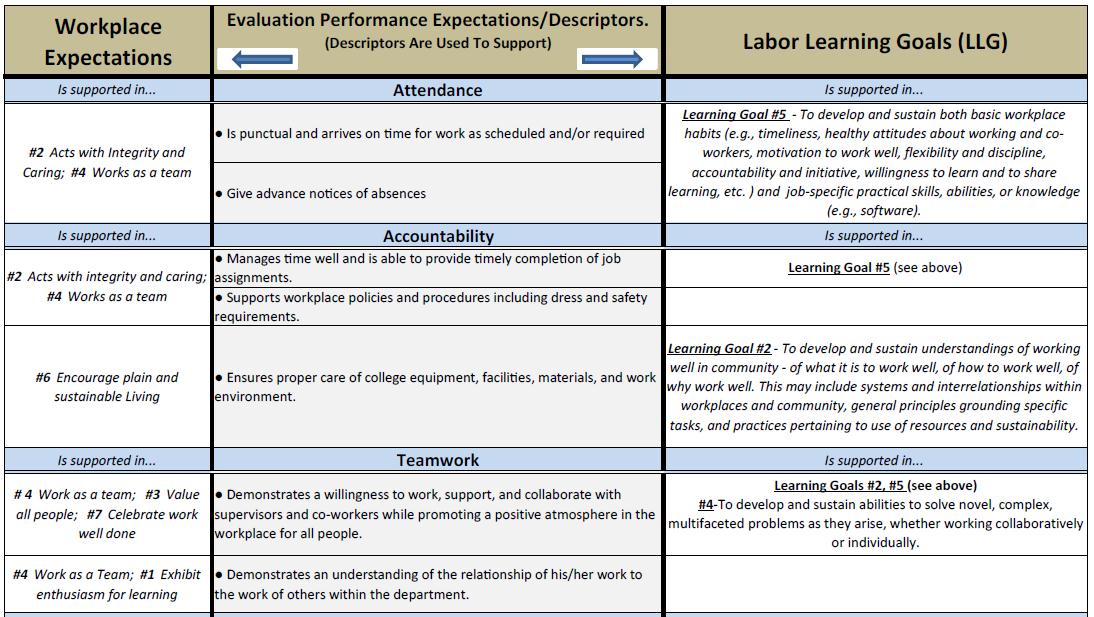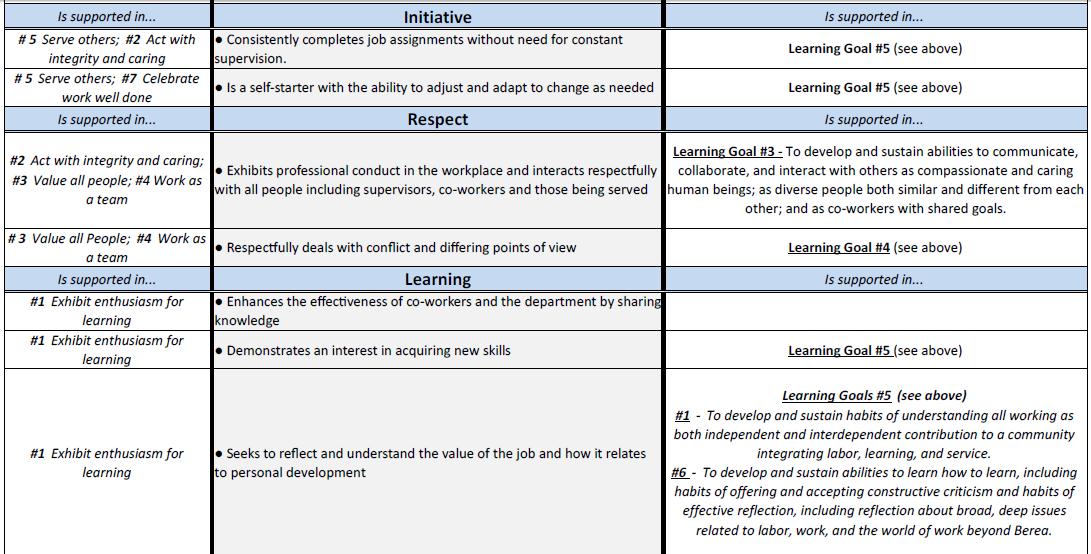Student Labor Evaluation (SLE) an on-line web based tool
The Student Labor Evaluation (SLE) process promotes student personal and professional development in the workplace by establishing performance standards consistent with the Berea College Workplace Expectations, assessing fulfillment of those standards, and determining ways in which the student and supervisor(s) / mentor(s) can collaborate to enhance student learning opportunities. The completion of this regular evaluation process creates a documented work performance history for each student as well as fulfills Berea College and federal compliance guidelines.
As part of the development plan, students should expect supervisors to conduct a mid-point evaluation at the middle of the labor position participation agreement period and a final evaluation at the conclusion of the labor position participation agreement (defined by the status form). In addition, supervisors are encouraged to have periodic conversations with students about position performance and to offer suggestions as well as provide opportunities for continued reflection and growth. Evaluations focus on seven (7) core areas of position performance including: attendance, accountability, teamwork, initiative, respect, learning, and position specific (based on individual departmental position descriptions).
Labor evaluation results are a central component of the labor transcript with performance ratings appearing for each position in a term or summer period. Because these performance ratings provide an advantage in future career seeking opportunities, students should strive to perform at the highest levels in every position held at Berea College.
Students who are not performing satisfactorily in a labor position and receive a score of 59 or below, are subject to being placed on labor probation for unsatisfactory performance within the department.
Staff or Faculty Labor Supervisors assume the role of practical instructors within the program and evaluate, using the Student Labor Evaluation (SLE) described below, the student’s performance based on seven performance expectations (learning outcomes). Descriptors under the performance expectations describe the general learning outcomes that apply to the performance expectation. The descriptors are also linked to the seven Labor Learning Goals of the program and to the Workplace Expectations* of the college that apply. The seventh performance expectation “Position Specific” ties directly to the position description which defines the specific skill sets and requirements of the position which are evaluated under the position specific expectation. All student labor positions are defined by a position description and include specific learning opportunities and required skill sets that are embedded in the position. See the summary spreadsheet below to view how the various learning outcomes are integrated/linked to the seven performance expectations.
* Workplace Expectations describes the expected attributes that every faculty, staff, and student worker should demonstrate and support in the workplace environment on the Berea campus.


Labor Experience Evaluation (LEE) is an on-line web-based tool
The Labor Experience Evaluation (LEE) is an assessment tool designed to provide student feedback to those responsible for Labor Program effectiveness at the supervisor, department, and program levels. Student responses to the LEE are one of many sources of information used by Labor Program personnel in their efforts to improve the educational quality of the student work experience at Berea College.
The Labor Experience Evaluation allows students to reflect upon their overall labor experience while at Berea College. This survey allows students to evaluate back to us their labor experiences in five key areas:
- Learning through work experiences
- The relationships between work and academics
- Four core general educational goals
- Evaluation of the local work area
- Evaluation of the Labor Program (Labor Program Office, and Student Payment Office)
Students are required towards the end of the academic year and, if engaged in a summer labor position, towards the end of summer to evaluate and reflect on their labor experience through the Labor Experience Evaluation (LEE). Labor departments should set aside time to allow the student to complete this evaluation during work time. The majority of the departments will utilize the weekly Tuesday 4-5 PM Labor Meeting time to allow their students to complete this web based on-line evaluation. The Labor Department Administrator and Labor Supervisor is given access to the evaluations completed by the students working in the department after the completion of a labor assignment and not before. Personal information (including name. class, gender…) that could identify a student is removed. The purpose of this is to provide the means for the Department Administrator to be able to assess, with the department labor supervisors, the effectiveness of the learning occurring across the department.
Labor Program Evaluation (LPE) is an on-line web-based tool
Presently under development, this on-line tool will allow Labor Supervisors and Department Administrators to evaluate the Labor Program Administrative offices and services provided which includes student payroll.
Assessment
Labor supervisors, departments, and the labor program utilize the two evaluation tools (SLE and LEE) to assess the educational performance and effectiveness of the program and implement appropriate changes based on the assessment. Assess is given to the Labor Supervisors to review on-line the LEE responses from their student workers. Department Administrators are given access to review on-line the SLE and LEE of student workers in their department(s). The data reviewed does not include the name of the student and access to the data is only given after the academic year or summer period has ended. The Labor Program maintains the data and creates SLE and LEE department reports that are distributed to the administrator of the department(s). The Labor Program working with Institutional Research provides assistant to the departments in assessing the data contained in the department reports and mines the data to assess educational performance within the institution and across the department areas.
Customized Evaluations
Some departments supplement the primary evaluation with a departmental tool to address items specific to their workplaces. This can be particularly useful for departments where the work requires a high degree of skill or specialization, where there are additional compliance or safety factors, where unique organizational structures are in place, or where new programs or personnel are involved.
Custom evaluations can also be developed to address work topics rather than individuals. If a department is concerned about productivity, workflow, organizational structure, service, etc., a custom evaluation tool may be used to identify areas for improvement. The Labor Program Office will assist departments in thinking about these additional forms of assessment for the enhancement of individual departments.
Two-Way Feedback
In addition to formalized assessment measures, supervisors are encouraged to regularly engage students in two-way feedback. This term describe a feedback process that allows both the feedback giver and the feedback recipient to experience both roles in a reciprocal fashion. In effect, both people fully experience the feedback process by being on the giving and receiving end of constructive criticism.
The content of such a conversation is determined by questions that are asked and answered, in turn, by all participants in the dialogue. For example: “What are we each doing that is working and needs to continue?” “What needs to be changed or adapted?” There are several inherent challenges to this process, including: building reflection time into a work schedule, fear of receiving unhelpful or painful criticism, and overcoming the traditional idea that a supervisor knows more than their worker and thus does not need to receive constructive criticism. However, the benefits of this kind of feedback, more often than not, far outweigh the risks.
Feedback is a core component of any learning environment. This type of interaction allows a student to learn from an experience by processing it, receiving positive reinforcement, and being challenged to try new and different ways of doing things. Supervisors, through two-way communication, also open themselves up to becoming learners through careful listening, receptivity of constructive criticism, and a genuine willingness to adjust supervisory style or method. The supervisor, in essence, switches roles with the student to become the recipient and not just the feedback agent. Two-way feedback is most effective when performed orally in a one-on-one setting, but in the interest of time, supervisors may use written tools or engage in feedback in small groups.
The following questions may serve as a useful guide to giving and receiving feedback in this way:
- During my labor position I have observed my supervisor / worker learn and grow in the following ways:
- How does my leadership style compliment that of my supervisor / worker?
- What might I do differently to contribute more to my success and to the success of my work environment?
- Do we use our meeting times productively? What about our meetings needs to change / stay the same?
- What would I like my supervisor / worker to keep doing?
- What would I like to see my supervisor / worker do differently?
- How would I like my supervisor / worker to communicate with me (support, conflict, concerns, and ideas)?
- How successful have we been in fulfilling expectations? What needs work?
- How can we continue all the positive things that are happening?
- How can I better support my supervisor / worker?